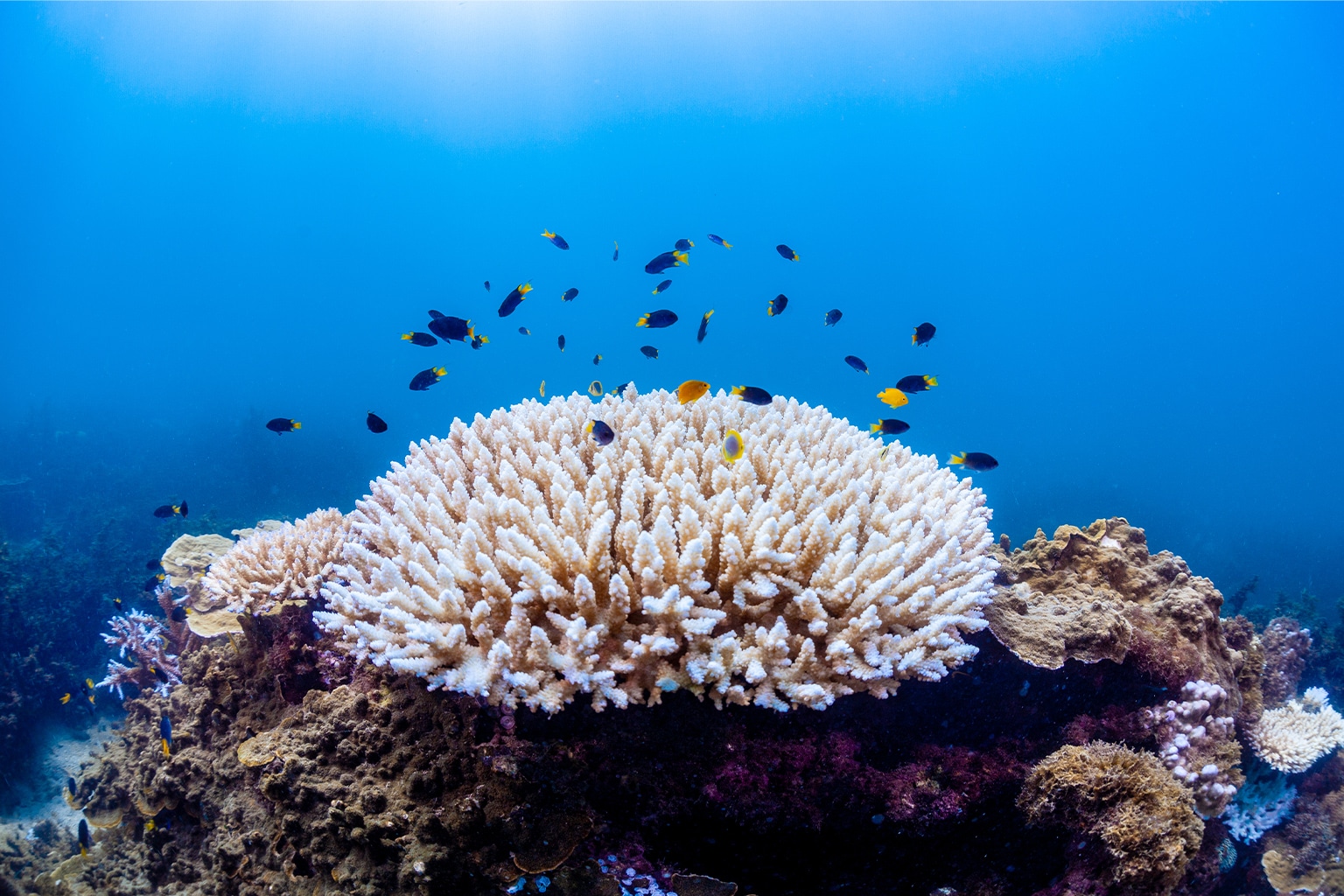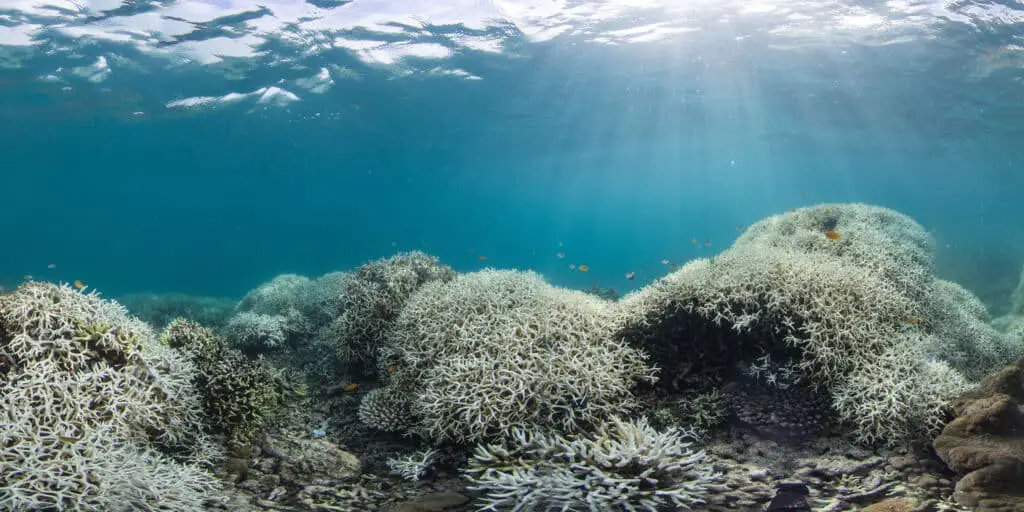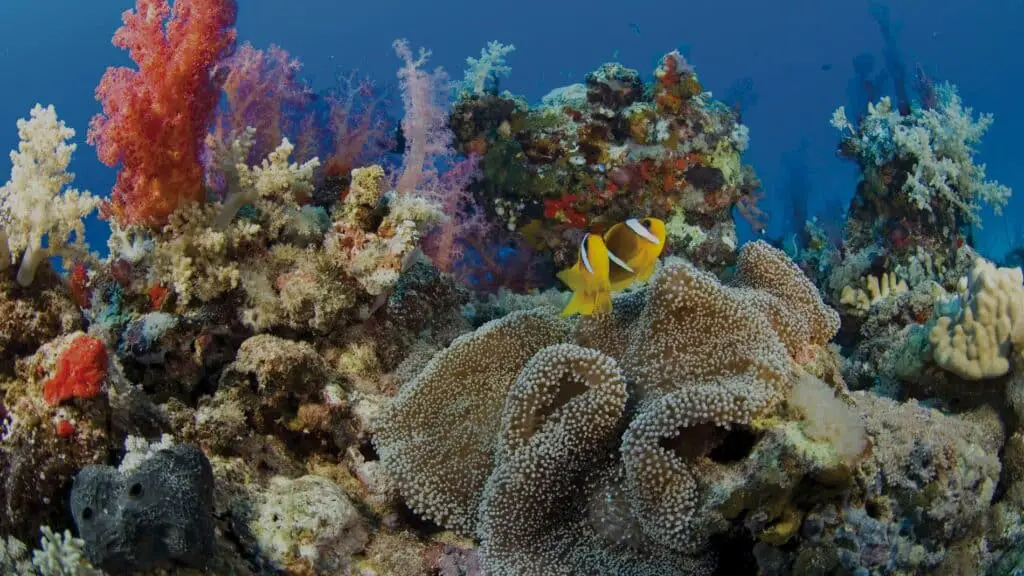Why Are Coral Reefs Disappearing

Introduction
Why Are Coral Reefs Disappearing: Coral reefs, often referred to as the “rainforests of the sea,” are some of the Earth’s most diverse and vibrant ecosystems. These underwater wonderlands are not only home to a vast array of marine species but also provide invaluable services to humans, such as shoreline protection and fisheries support. However, coral reefs are under severe threat, and their continued disappearance is a cause for global concern.
The primary driver behind the decline of coral reefs is climate change. Rising sea temperatures, a consequence of global warming, trigger coral bleaching events. When corals expel the symbiotic algae that provide them with nutrients and color, they become pale and vulnerable to disease. Repeated bleaching events weaken and eventually kill the corals, leaving behind lifeless skeletons.
Another critical factor contributing to coral reef degradation is pollution, particularly from land-based sources. Agricultural runoff, sewage, and industrial discharge introduce excess nutrients and harmful chemicals into coastal waters. This pollution fuels the growth of algae that can smother coral reefs and disrupt the delicate balance of these ecosystems.
In this essay, we will delve deeper into these factors, exploring how climate change, pollution, and overfishing are interlinked and contributing to the alarming disappearance of coral reefs. We will also discuss the consequences of this loss and the urgent need for global conservation efforts to save these invaluable ecosystems.

Why are coral reefs dying because of climate change?
Climate change leads to: A warming ocean: causes thermal stress that contributes to coral bleaching and infectious disease. Sea level rise: may lead to increases in sedimentation for reefs located near land-based sources of sediment. Sedimentation runoff can lead to the smothering of coral.
Coral reefs, among the most diverse and spectacular ecosystems on Earth, are perishing due to the relentless impacts of climate change. Climate change, driven primarily by human activities such as the burning of fossil fuels and deforestation, is causing profound alterations in the world’s oceans, and coral reefs are particularly vulnerable.
One of the most significant contributors to coral reef demise is ocean warming. As global temperatures rise, sea temperatures also increase, leading to a process known as coral bleaching. Corals have a symbiotic relationship with tiny algae called zooxanthellae, which provide them with vital nutrients and vibrant colors.
However, when water temperatures become too high, corals expel these algae, causing them to turn white and become stressed. If the stress continues, the corals die. The frequency and severity of coral bleaching events have surged due to climate change, leaving reefs weakened and less able to recover.
Ocean acidification, another consequence of increased carbon dioxide levels in the atmosphere, hampers the ability of corals to build their calcium carbonate skeletons, essential for their structure and survival. This process weakens the overall resilience of coral reefs.
Are coral reefs disappearing?
However, coral reefs are disappearing worldwide. We know this through extensive surveys conducted every decade. “Since 2009, the United Nations-supported Global Coral Reef Monitoring Network found that 14% of the corals have disappeared, and things are speeding up,” stated Dr.
Coral reefs, once thriving and vibrant ecosystems, are undeniably disappearing at an alarming rate. The decline of coral reefs is primarily attributed to various human-induced stressors and environmental changes.
One of the most critical factors contributing to their disappearance is climate change. Rising global temperatures have led to ocean warming, which triggers coral bleaching events. During these events, corals expel the symbiotic algae that provide them with essential nutrients and color, leaving them vulnerable to disease and death. Climate change also results in ocean acidification, which impairs the ability of corals to build their calcium carbonate skeletons, crucial for their structural integrity.
Pollution from land-based sources, including agricultural runoff and industrial discharge, introduces excess nutrients and harmful chemicals into coastal waters. This pollution fosters the growth of algae that can smother coral reefs and disrupt their delicate balance.
Overfishing and destructive fishing practices, such as the use of dynamite or cyanide, further contribute to coral reef degradation. Removing key herbivorous fish species disrupts the natural controls on algae growth, leaving corals more susceptible to competition from these invasive species.
The consequences of coral reef disappearance are profound, impacting not only the rich biodiversity of these ecosystems but also the millions of people who depend on them for food, income, and coastal protection. Therefore, urgent and concerted efforts are necessary to mitigate these threats and preserve these invaluable ecosystems before they vanish entirely.
Why are coral reefs dying and how can we save them?
Marine debris can be harmful to coral reefs. Recycle your trash at home and on the go (especially plastic), and remember the three R’s (reduce, reuse, and recycle). When disposing of trash, do it properly in bins, to avoid trash being blown or washed away into waterways and oceans.
Coral reefs, once teeming with life and color, are dying due to a multitude of interconnected factors. Understanding these threats and implementing effective conservation measures is crucial to their survival.
- Climate Change: The foremost threat to coral reefs is climate change. Rising sea temperatures cause coral bleaching, wherein corals expel the symbiotic algae vital for their health. To save reefs, we must address climate change by reducing carbon emissions and supporting initiatives like coral transplantation and assisted evolution.
- Ocean Acidification: Increased atmospheric carbon dioxide is absorbed by the oceans, leading to ocean acidification. This makes it difficult for corals to build their calcium carbonate skeletons. Reducing CO2 emissions and preserving local ecosystems that naturally buffer acidity are essential steps.
- Pollution: Land-based pollution from agriculture, industry, and coastal development introduces excess nutrients and toxins into the ocean. Implementing better waste management, reducing runoff, and using eco-friendly farming practices can mitigate this threat.
- Overfishing: Unsustainable fishing practices, such as destructive methods and overharvesting, disrupt the balance of coral reef ecosystems. Establishing marine protected areas and promoting sustainable fishing practices help conserve fish populations and their habitats.
Do coral reefs have a future?
By the 2030s, most coral reefs are projected to experience coral bleaching at least twice per decade, and possibly every year by the 2040s. This frequency would prevent coral recovery between episodes. Without drastic change, coral reefs could disappear by 2100.
Climate change remains the greatest threat to coral reefs. Rising sea temperatures and ocean acidification continue to cause coral bleaching and weaken these ecosystems. To secure a future for coral reefs, we must reduce greenhouse gas emissions through international agreements and sustainable practices.
Efforts to mitigate coral bleaching include coral restoration projects, which involve transplanting resilient coral species and experimenting with heat-resistant varieties through assisted evolution. Such initiatives offer a glimmer of hope for reef recovery. Local conservation measures are equally vital. Marine protected areas, fishing regulations, and sustainable tourism practices help preserve the resilience of coral reefs.
The future of coral reefs depends on our collective actions. While the challenges are immense, the combined efforts of governments, organizations, scientists, and communities worldwide can ensure that these precious ecosystems continue to thrive. Coral reefs can have a future, but it requires immediate and sustained commitment to safeguarding their health and resilience against the threats they face.
How can we solve coral reefs dying?
How you can help coral reefs
- Reduce your carbon footprint.
- Conserve water to reduce pollution.
- Get engaged.
- Support sustainable fishing.
- Support sustainable development and tourism.
- Help inform the public.
- Donate to the project.
Solving the crisis of dying coral reefs requires a multi-faceted approach that combines conservation efforts, scientific research, and global cooperation. Firstly, reducing carbon emissions is paramount. Transitioning to renewable energy sources and implementing stricter regulations on fossil fuel consumption is crucial in mitigating ocean acidification and rising sea temperatures, which are primary drivers of coral bleaching.
Local conservation initiatives play a pivotal role. Establishing marine protected areas and enforcing sustainable fishing practices helps safeguard reef ecosystems from overexploitation and destructive activities. Additionally, reducing pollution runoff from coastal areas through improved wastewater management and sustainable agriculture practices helps maintain water quality essential for coral health.
Advancing scientific research is equally essential. Investing in studies focused on coral resilience, genetic diversity, and breeding programs can help identify and propagate more resilient coral strains. Moreover, technological innovations like 3D-printed coral structures and coral-assisting robots show promise in assisting damaged reefs to recover.
Ultimately, international collaboration is indispensable. Coordinated efforts between governments, NGOs, and the private sector are necessary to implement large-scale conservation strategies and policies. By addressing the complex challenges facing coral reefs with a comprehensive and collaborative approach, we can hope to restore these invaluable ecosystems for future generations.
How much coral reef has disappeared?
Rising sea surface temperatures driving the loss of 14 percent of corals since 2009. Nairobi, 5 October 2021 – The “Status of Coral Reefs of the World: 2020” report, released today, documents the loss of approximately 14 per cent of the world’s coral since 2009.
Since the late 20th century, coral reefs have experienced alarming declines worldwide. It is estimated that approximately 30-50% of the world’s coral reefs have already disappeared, and an additional 20% are at risk of imminent collapse. These losses are primarily attributed to human activities, with climate change being a significant driver.
The phenomenon of coral bleaching, induced by rising sea temperatures, has had devastating effects. Between 2014 and 2017, a global coral bleaching event affected reefs across the Pacific, Atlantic, and Indian Oceans, causing widespread damage and mortality. Ocean acidification, a consequence of excess carbon dioxide absorption by seawater, further weakens coral structures and impedes their ability to grow.
It’s crucial to recognize the urgency of this situation and take concerted action to protect and restore remaining coral reefs. Initiatives focusing on reducing greenhouse gas emissions, implementing sustainable marine resource management, and creating marine protected areas are essential steps in reversing this devastating trend and preserving these invaluable ecosystems.
What will happen if coral reefs are destroyed?
Recently with rising ocean temperatures due to climate change, coral has begun to bleach. Coral bleaching is the first sign of coral death. If too many reefs die, this can lead to the destruction of marine ecosystems and even the extinction of some fish.
The destruction of coral reefs would have far-reaching and devastating consequences for both marine ecosystems and human populations. Here are some of the key outcomes if coral reefs were to disappear:
- Loss of Biodiversity: Coral reefs are among the most biodiverse ecosystems on Earth, hosting a staggering variety of marine life. If destroyed, countless species of fish, invertebrates, and other organisms would lose their habitats, leading to a dramatic loss of biodiversity.
- Fisheries Collapse: Coral reefs are essential for the survival of many commercially valuable fish species. Their destruction would lead to the collapse of fisheries, threatening the livelihoods and food security of millions of people who rely on reef fish.
- Coastal Protection: Coral reefs act as natural barriers, protecting coastlines from erosion and storm damage. Without reefs, coastal communities would be more vulnerable to the destructive forces of waves and hurricanes.
- Tourism Decline: Coral reefs are major tourist attractions, drawing visitors from around the world. The disappearance of reefs would impact the tourism industry, leading to economic losses for coastal regions.
- Carbon Storage: Coral reefs play a role in carbon storage by absorbing and storing atmospheric carbon dioxide. Their destruction would reduce this capacity, potentially exacerbating climate change.
The destruction of coral reefs would trigger a domino effect, causing ecological, economic, and societal consequences on a global scale. Preserving these fragile ecosystems is not just a matter of environmental protection but also a necessity for the well-being and sustainability of our planet.
How does climate change affect coral reefs?
Climate change poses a grave threat to coral reefs, which are among the most diverse and vital ecosystems on our planet. Rising global temperatures, primarily driven by the accumulation of greenhouse gases in the atmosphere, have far-reaching consequences for these underwater marvels.
One of the most immediate and destructive impacts of climate change on coral reefs is coral bleaching. When water temperatures become excessively high, corals expel the symbiotic algae living within their tissues, causing them to turn white and become vulnerable to disease. Repeated bleaching events can lead to coral death, resulting in the loss of biodiversity and the intricate habitats these reefs provide for countless marine species.
Ocean acidification, another consequence of increased carbon dioxide levels, affects coral reefs as well. Elevated CO2 levels lead to more acidic seawater, which makes it difficult for corals to build and maintain their calcium carbonate skeletons. This weakened skeletal structure leaves corals susceptible to damage from storms and erosion.
The sea-level rise associated with climate change can lead to increased sedimentation, which can smother coral reefs, impeding their growth and recovery. Overall, the multifaceted impacts of climate change are causing widespread degradation of coral reefs, threatening the entire marine ecosystems that rely on them and underscoring the urgent need for global action to mitigate climate change and protect these invaluable ecosystems.

Conclusion
Coral bleaching, driven by rising sea temperatures, is a stark reminder of the devastating impacts of global warming on marine ecosystems. Pollution, particularly nutrient runoff, fuels the growth of harmful algae, smothering coral reefs and disrupting their fragile balance. Overfishing, if left unchecked, further weakens these ecosystems by removing key species that help maintain their health.
The consequences of coral reef loss are profound. Beyond the ecological devastation, coastal communities that rely on reefs for food and protection from storms face increased vulnerability. The tourism industry, which depends on the allure of vibrant reefs, also suffers. Moreover, the loss of biodiversity within coral reefs diminishes our understanding of the ocean’s intricate web of life.
Urgent action is imperative. Efforts to mitigate climate change, reduce pollution, and implement sustainable fishing practices are essential for coral reef survival. Local and global initiatives, along with public awareness and education, can make a difference in preserving these invaluable ecosystems.
In preserving coral reefs, we not only protect the beauty and biodiversity of our oceans but also safeguard the well-being of countless communities and the resilience of our planet in the face of a changing climate. It is a collective responsibility to ensure that future generations can continue to marvel at the wonders of these underwater worlds.



